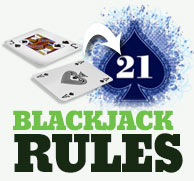
Blackjack Rules: How to Play Blackjack
Blackjack is one of the more complex games in any casino, online or brick-and-mortar. As such, it's a game that you'll really want to know pretty well before you start playing. That said, it's definitely worth the time it takes to learn the rules, as blackjack offers some of the best odds in all of online gambling. Here's a complete guide to the rules of blackjack that should get you up to speed on how this classic casino game works.
Basic Blackjack Setup
Blackjack is played by one or more players against a dealer who represents the casino. The object of the game is to make a hand as close to 21 points without going over. The cards for the game come from a variable number of standard decks of playing cards which are traditionally held in a shoe. Typically, a shoe will have between six and eight decks, though smaller shoes are also common. Some internet gambling sites will instead use an "infinite" shoe, meaning every card is just as likely to come up at any time.
Card values in blackjack are determined by the rank of each card. Numbered cards are worth their numerical value, while all face cards are worth ten. Aces can count as either one point or 11, depending on what is more advantageous for the player (this can change in a single hand, with an ace changing from 11 to one to help a player avoid going over 21).
At the start of each hand, each player is dealt two cards face up. The dealer is dealt one face up card, and in most blackjack variations, is also dealt a "hole card" face down.
Blackjack Pages on
Checking for Blackjacks

If the dealer is showing an ace, they will offer players a special insurance bet. This bet costs half the money of the original bet made by the player, and pays out at 2-1 odds only if the dealer actually has a blackjack. This has the effect of allowing a player to break even if the dealer has blackjack. If a player already has blackjack, this insurance bet will typically be called "even money," as the dealer will simply offer the player even money on their blackjack (as this would be the ultimate result of taking an insurance bet whether it won or lost).
After all insurance bets have been offered, the dealer will check for a blackjack (he will also do this if he is showing a ten). If the dealer has a blackjack, it is revealed and all player hands lose (again, blackjacks push). If the dealer doesn't have blackjack, the hand then proceeds.
Playing Hands

Stand: The player takes no more cards, and stands with the hand they currently have.
Hit: The player takes an additional card from the dealer. Assuming the player does not go over 21, the player may then choose to hit again or stand.
If a hand ever goes over 21, that hand is said to have "busted." If a player hand busts, all bets associated with that hand immediately lose.
Special Actions

Double Down: The player places a second bet equal in size to their initial bet. In exchange, the player receives one additional card, after which they must stand. Both bets will now win or lose together based on the results of the hand.
Split: This option is only available to the player if the player has two cards of the exact same rank. In this case, the player has the option of placing a second bet and splitting their pair into two separate hands. Each of these hands will then be dealt a second card, and can be played independently of each other. Depending on the rules at a particular online gambling site, players may be able to re-split their hands if they are once again dealt pairs, though usually not to more than a maximum of four hands. In addition, split aces are often given just one card, after which they must stand.
Surrender: This option is available in most (but not all) blackjack games. If available, the player may forfeit their hand immediately at the cost of half of their bet. This action is normally taken in the most hopeless situations in order to avoid losing a player's entire bet.
Dealer Actions
Once all players have completed playing their hands, the dealer will then play out their own hand. They will begin by revealing their hole card, and will then continue to play based on rules that can vary slightly from game to game. In all standard blackjack games, the dealer will always hit with 16 or less, and will always stand with 18 or more.
However, you will find some variation in what happens on hands of 17, with even different games at the same internet gambling site sometimes having different rules. In some games, the dealer will stand on all 17s. In other games, the dealer will stand with a hard 17, but will hit with a "soft" 17 – that is, a hand in which the dealer has an ace that still counts as 11 points. The dealer will hit in this situation because they cannot bust; no matter what card they receive, the aces in their hand can revert back to counting as just one point if necessary.
Resolving Bets
If the dealer goes bust, all players remaining in the hand will win even money on all remaining bets. If the dealer stands, players win even money only if their hand is of a higher value than that of the dealer. If the dealer hand is higher than a player hand, all bets on that hand lose.
Finally, if the dealer hand has the same value as a player hand, that hand is scored as a push. When this occurs, all bets on that hand are returned to the player.
